
Leo is an ancient constellation that is both large and visually stunning. It has long captivated the interest of space enthusiasts around the world. Detailed information about Leo can be found below.
The earliest record
There are various accounts regarding the origin of the Leo constellation. One of the most popular versions comes from ancient Greek mythology, which recounts the tale of Heracles defeating the Nemean Lion and offering it as a sacrifice to his father, Zeus. It is said that Zeus wanted to commemorate his son’s heroic feat by immortalizing it in the form of a constellation.
Ancient Egyptian myths include references to the constellation. During this era, individuals held the belief that celestial bodies were closely linked to natural events. According to their understanding, when the stars within a specific constellation shone brightly, it indicated the presence of a heat wave. This was also the time when the desert became the domain of the king of beasts. As a result, the constellation was named accordingly.
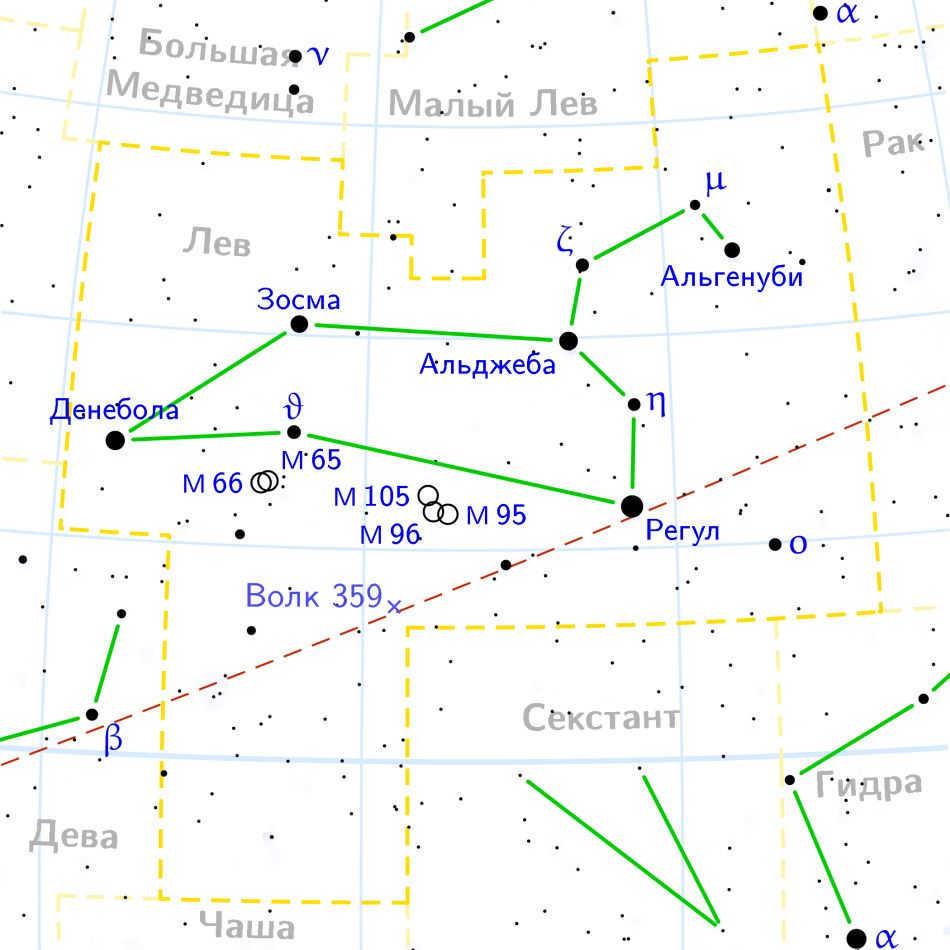
Astrologers from ancient Sumeria and Mesopotamia were also aware of this celestial body. However, the first referred to it as the Ill Dog.
Mesopotamian astronomers, on the other hand, identified it as the Lion. The constellation could not be overlooked by Babylonian priests, who referred to it as the Great Lion.
As a result, there is no definitive data on the exact discovery of this constellation, but references to it can be found in various sources.
Leo is a group of stars that the paths of the ecliptic and the celestial equator pass through. It can be found positioned between the constellations of Virgo and Cancer. In close proximity are also the well-known Big Dipper and various other celestial entities.
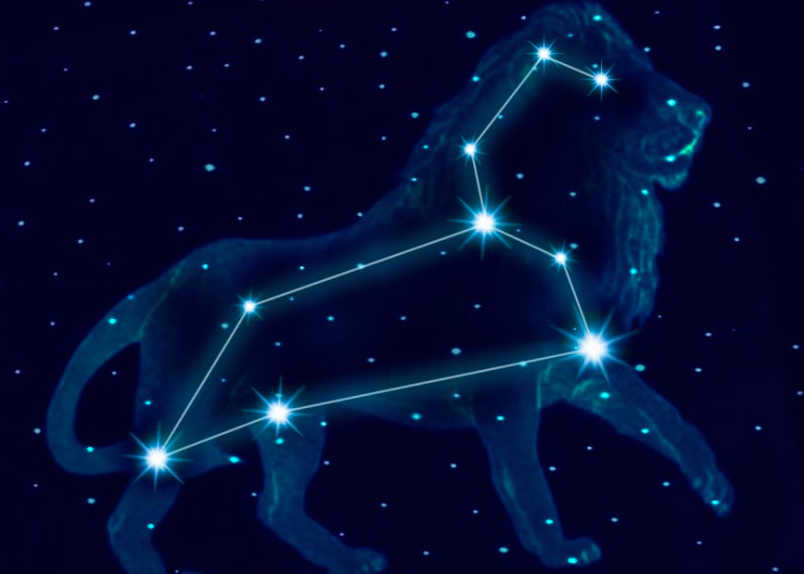
Leo is a constellation that is known for its bright stars and is ranked 12th in magnitude. It is easily recognizable in the sky due to its distinct shape. Additionally, by locating Leo, you can also spot other constellations.
Leo is classified as a “spring” constellation, as its stars shine the brightest during this season. However, it can still be observed in the sky during the winter, summer, and fall months.
Geographical Position
The Leo constellation can be observed from any part of Russia. It is situated in the northern hemisphere. Virgo is positioned on one side of Leo, while Cancer is located on the other side. This constellation lies along the ecliptic, which is the path of the Sun, and is a part of the zodiac circle.

Moreover, Leo is adjacent to neighboring constellations like Ursa Major, Sextans, Crater, Leo Minor, as well as Coma Berenices, Hydra, and Lynx.
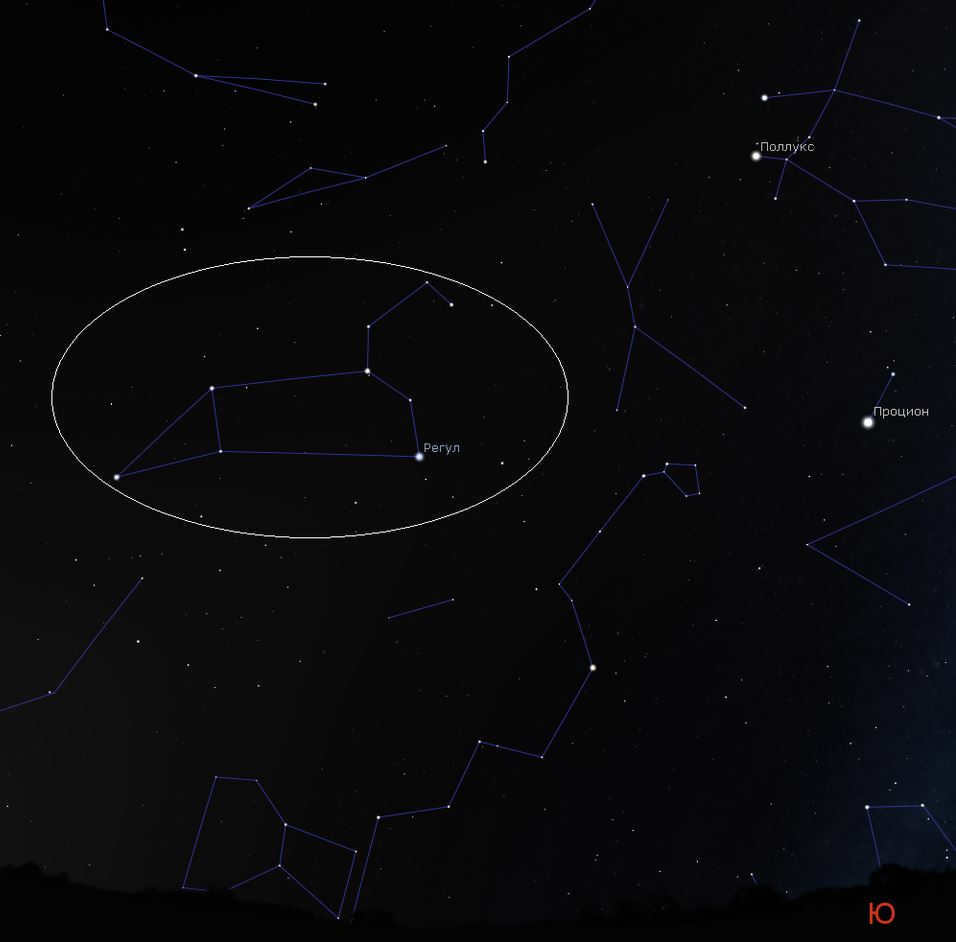
The constellation can be observed in various ways. One method is by utilizing the moon. To accomplish this, one must determine when the moon will align with the Lion, the natural satellite of the Earth serving as an accurate indicator of its position.
Another way to locate the Lion is by referencing the Big Dipper, which is situated to the north of this constellation. If one visualizes the pouring of water from the Dipper’s bucket, it will coincide with the position of the Lion.
Identification of the constellation can also be accomplished by locating its brightest star, Regulus. Adjacent to Regulus are several other luminous stars that collectively form a trapezoid shape.
The primary entities
The star constellation known as Leo contains more than 120 celestial bodies. However, only the six most luminous stars form its “head”:
- Regulus. This star is the brightest in Leo and the 22nd brightest in the entire night sky. It is located a mere 78 light years away from Earth. Many individuals mistakenly believe that Regulus emits its radiance alone. In reality, it is composed of two pairs of stars. Therefore, Regulus consists of four individual stars. The first pair contains a blue-colored object known as Regulus A. The second pair consists of a white dwarf, which is often difficult to observe due to its frequent overlap with the Moon, Mercury, and Venus. This second pair is made up of an orange and red dwarf.
- Denebola is the third brightest star in the constellation. It is situated approximately 36 light years away from Earth. In addition, it is the second brightest star in the constellation and the 61st brightest star in the sky. Denebola emits a luminosity that is 12 times greater than that of the Sun, and it has a mass that is 1.8 times the mass of the Sun. The star exhibits a constant twinkling effect and undergoes changes in its color every 2-3 hours. This phenomenon is attributed to Denebola being a hot white giant star. Its layers move in and out, which causes the flickering effect.

- Algieba. It is situated at a distance of 120 light years from our planet. This celestial body is also made up of a binary star system. Algieba A, one of the stars, is an orange giant that emits light 180 times brighter than the Sun. The other member of the pair is a yellow giant, shining 50 times brighter than the Sun.
- Algenubi. It is the fifth most luminous star in the constellation.
- Zosma tlt. Astronomers predict that in 600 million years, this star will transform into a red giant. Currently, it shines 15 times brighter than the Sun.
- Hort. With a mass 2.5 times that of the Sun, this star is visible to the naked eye.
Asterisms
Asterisms are groups of stars that make up constellations.
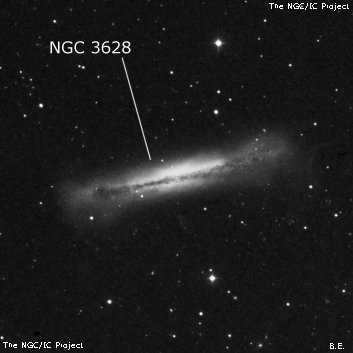
They have a sickle-like appearance, which includes entire galaxies, namely:
- M65 (Monsieur 65). Charles Messier discovered this galaxy in 1780. It is characterized by a lack of substantial dust and gas, resulting in relatively low levels of star formation.
- M66 (Monsieur 66). Charles Messier also discovered this galaxy in 1780.
- NGC 3628. William Herschel discovered this galaxy in 1784.
These galaxies belong to the spiral type and are located 35 million light years away from us.
Distinctive Characteristics
Curiously, Arab astronomers bestowed the title Kalb Al-Asad upon the primary luminary in the constellation. This designation signifies the essence of the Lion. Conversely, Europeans named it Regulus, which can be interpreted as Prince.

The second brightest star in the constellation is known as Danab Al-Asad, which translates to the Tail of the Lion.
Here are some other interesting facts about the constellation:
- Within the constellation lies Wolf 359, the fifth most distant star from the Sun. Discovered in 1918 through astrophotography, this star is not visible to the naked eye but can be observed with specialized equipment.
- The constellation is also the location of the Leonids meteor stream, which is also referred to as a meteor shower. The last occurrence of this phenomenon was in 1998, and scientists predict it will happen again in 2031. The first recorded mention of this meteor shower was in 901.
Astrology: A Unique Perspective on the Stars
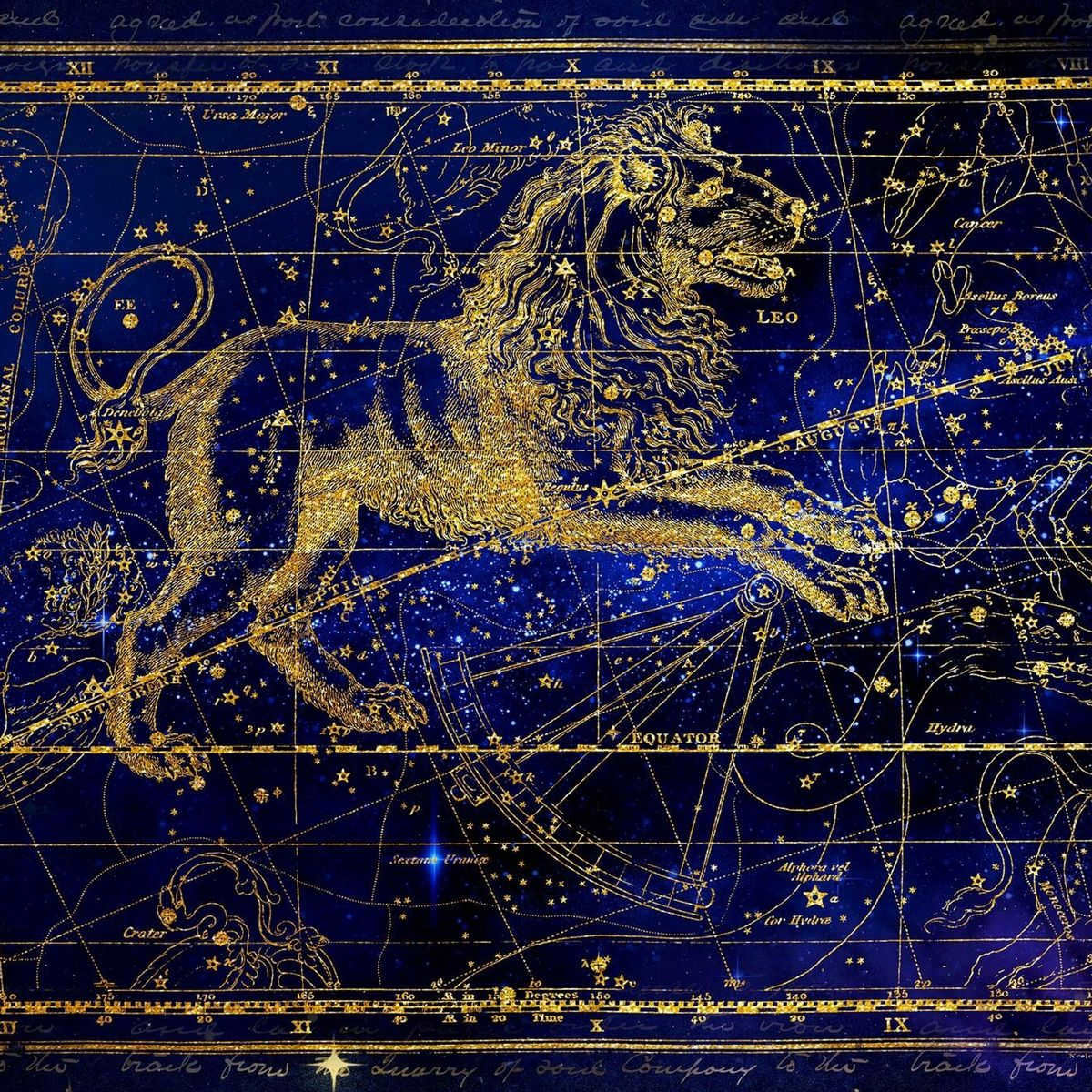
Leo is the fifth astrological sign in the zodiac, following Cancer and preceding Virgo. It is represented by the constellation Leo and is associated with qualities such as wisdom, courage, and strength. Leo’s astrological period spans from July 23rd to August 21st.
According to astrology, individuals born under the sign of Leo are known for their vibrant personalities and their ability to achieve great success in life. However, they must be cautious of arrogance and vanity, as these traits can hinder their progress.
Leo thrives in the spotlight and is known for being sociable and charismatic. They are always there for their loved ones in times of need, offering guidance and support. Leo’s cheerful nature and easy-going demeanor make them well-liked by many.
Questions-Answers
It reaches its highest point in the sky at midnight. It is visible to the naked eye.
Leo covers an area of 947 square degrees. It is the 12th largest constellation.
The best time to observe Leo is in February and March, and the Sun enters the constellation on August 10.
There is no specific date of Leo’s discovery. It is believed to have been discovered approximately 5,000 years ago.
Yes, Russians can observe the constellation from any part of the country at any time of the year. However, its stars may be more visible from certain locations.
Leo is one of the oldest constellations in the sky. It is not surprising that it is of great interest to space enthusiasts, both amateurs and professionals.
A video presentation on the scientific discoveries regarding the Leo constellation
Leo, the zodiacal constellation, can easily be seen by an observer in any part of Russia. It is situated between Cancer and Virgo and is known as the “King of Beasts”. Leo rises in the East and moves towards the southeast as the evening progresses. The group of faint stars that make up this constellation is best observed above the horizon on moonless nights, typically in March-April. Other nearby constellations that can be seen are the Lesser Leo, the Sextant, and the Bowl.
The constellation of the Lion, originally known as the Big Dog, was revered in ancient Mesopotamia during the second millennium BC. Its presence was documented in medieval Europe through the inclusion of the Lion constellation in the celestial catalog “Almagest”, authored by Claudius Ptolemy. Surviving manuscripts from the 6th century provide evidence of the observation of this distinctive constellation in ancient Russia.
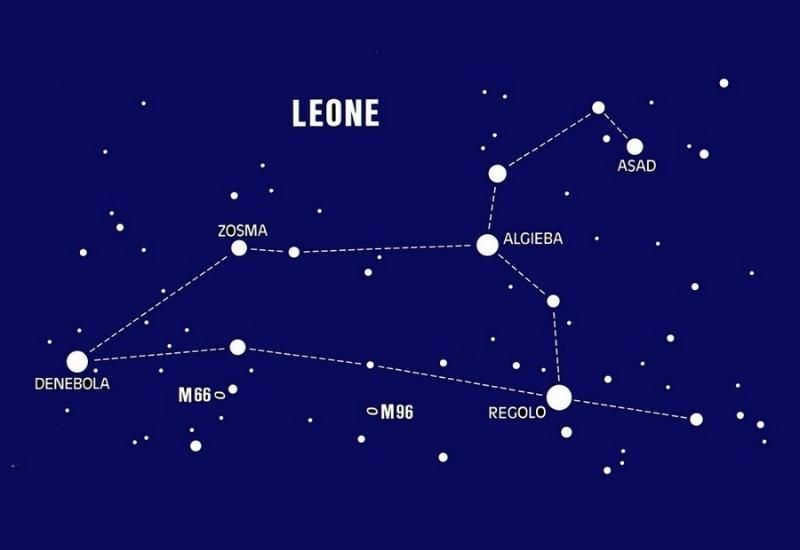
The Leo constellation is situated above the equator and consists of approximately 70 stars. Some of the most notable luminaries within this constellation include:
- Denebola. This celestial object belongs to the A spectral class and is located around 36 light-years away from our planet. It shines with a luminosity that is 12 times more powerful than that of the Sun.
- Regulus. As the brightest star in the Leo constellation, Regulus is classified as a B7 star. It is situated 77.5 light-years away from Earth and shines with a luminosity that is 160 times stronger than the Sun.
If you observe the constellation closely, it’s not hard to envision the familiar shape of a predator, with the head and chest represented by the asterism “Sickle”, which resembles a question mark. Therefore, it’s easy to guess the appearance of the Leo constellation.
The Leo Constellation on the Starry Sky Map
To locate the Leo constellation in the night sky using reference points, such as in February, you can look for the “big trapezoid”. It consists of 4 stars and is roughly the same size and brightness as the Big Dipper’s bucket. The brightest star, Regulus, can be seen in the lower right corner. This simple yet distinctive constellation is often utilized by astronomers to locate other groups of celestial objects.
Exploring the Leo Constellation in the Night Sky
Discovering the majestic “king of beasts” is a delightful experience that can be enjoyed during the spring season. Fortunately, locating the Leo constellation is not a daunting task. As darkness falls, it emerges prominently in the sky, positioned midway between the zenith and the horizon. During April nights, this constellation reigns supreme, asserting its dominance over the celestial expanse. Only the radiant stars Spica and Arcturus can rival Regulus, the shining star that serves as Leo’s brightest gem.
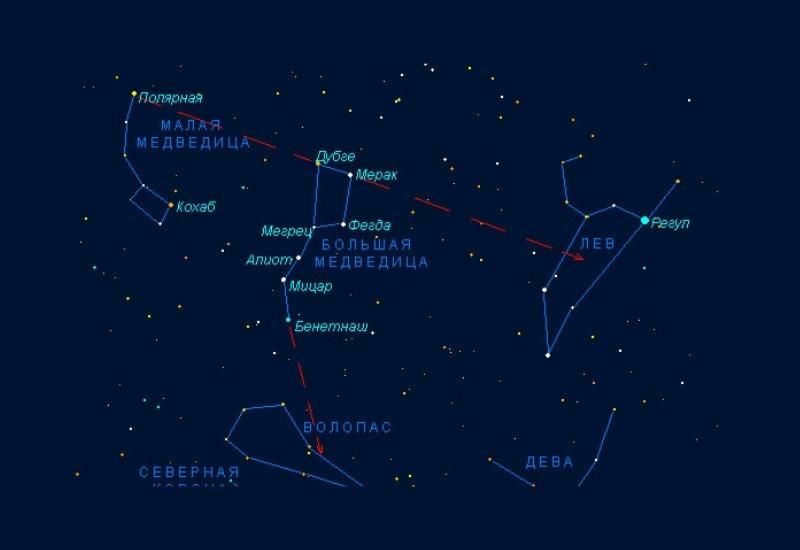
The constellation Leo can be easily located by using the well-known asterism known as the “Big Dipper” as a guide. The “Lion” can be found below the handle of this famous constellation. With this reference point, any astronomer or space enthusiast can quickly locate the majestic “king of beasts” in the evening sky. During the month of May, the sunset occurs later, allowing for several hours of observation of this remarkable constellation in the southwest.
"Leo" is made up of a variety of different stars: some bright, some dim, some dwarfs, some giants, and so on. Apart from Regulus and Denebola, there are other stars present in the constellation of Leo. One notable star is Algieba, a double star located at the base of the head that symbolizes the predator’s mane. Another interesting object in Leo is R Leo, which is a variable star with a long period.
Among the closest stars is Wolf 359, a red dwarf that shines 100,000 times fainter than the Sun. The distance to this faint star is estimated to be 7.80 light-years. DP Leo is also worth mentioning as it is a double star, with a white dwarf accompanying the red dwarf. In addition, this system contains a gas giant exoplanet among its minor objects.
The dazzling star Regulus or α Leo (Alpha Leo) in the constellation
It is acknowledged as the most brilliant in this constellation. The temperature on its surface soars to a staggering 10,000 degrees Celsius. It boasts a rotational velocity of 300 kilometers per second. Its age is estimated at around 50 million years. Regulus is part of a triple star system, as it attracts two satellites. The luminary was christened by Copernicus. It is referenced in computer games, television series, and feature films centered around space exploration.

Denebola: a Hot Star in the Leo Constellation
Denebola, also known as β Leo (Beta Leo), is the third most luminous star in the Leo constellation, following Regulus and Algieba. It is situated in the “tail” region and is located at a distance of 11 pc from the sun. The name, derived from Arabic, perfectly signifies its position in the constellation. With a surface temperature of 8,500 Kelvin, Denebola is a hot white dwarf star estimated to be around 100 to 380 million years old. Its luminosity is variable, undergoing active pulsation phases that cause a 0.25 m change in luminosity.
Double star Algieba or γ Leo (Gamma Leo)
Algieba is categorized as a binary star system. The mass of each star is estimated to be twice that of the sun. The primary star is identified as a yellow dwarf with a spectral classification of KO III. It has a surface temperature of 4470 Kelvin. The secondary star is a hotter orange-red star belonging to class G7IIIb. The distance of these celestial objects from the sun is approximately 122-130 astronomical units. The estimated age of the stars is around two billion years.
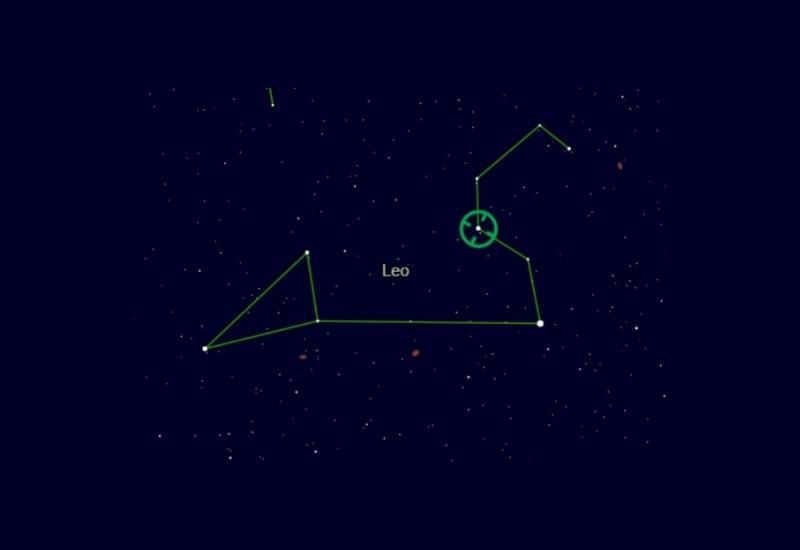
The enigmatic star Zosma or δ Leo (Delta Leo)
This triple star, which is white in color, can be found “on the back of the creature” and belongs to the main sequence. It falls under the spectral class A4. Recent data suggests that its stellar magnitude fluctuates by 0.3 m, indicating its variability. Zosma is classified as a Delta Shield-type celestial object. It is smaller than its parent star and is expected to fade away over the next 600 million years. Eventually, it will expand and transform into a red or orange giant before ultimately becoming a white dwarf.
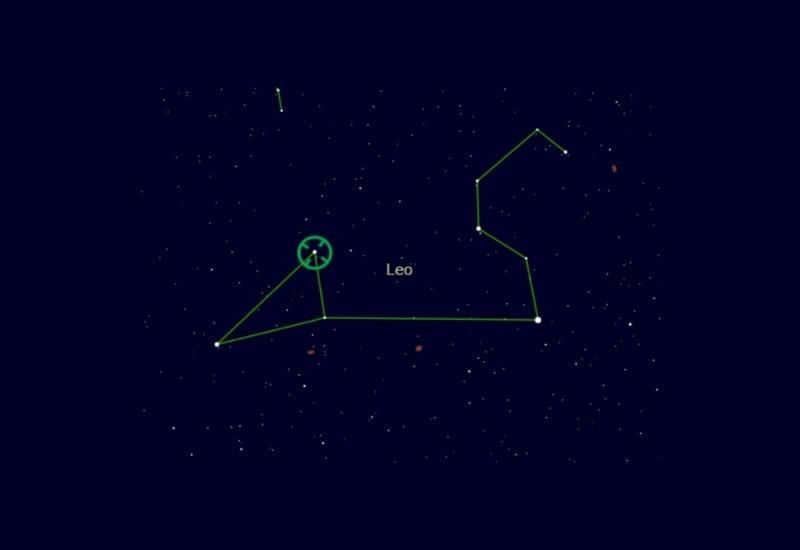
Single star Hort or θ Leo (theta Leo)
Hort, also known as θ Leo (theta Leo), is a solitary star that can be easily observed without any special equipment. It belongs to the spectral class A2, indicating that it is a white subgiant. The surface temperature of Hort is incredibly high, reaching up to 9320 Kelvin. Notably, its luminosity is characterized by a slow rotation, which is evident from the presence of metallic lines in its spectrum.
Scientists estimate that Hort was formed approximately 450 million years ago and has since remained as a single star. However, like all stars, it has a finite lifespan and will eventually transition into a white dwarf. Currently, Hort is located at a distance of 178 light years from the sun.
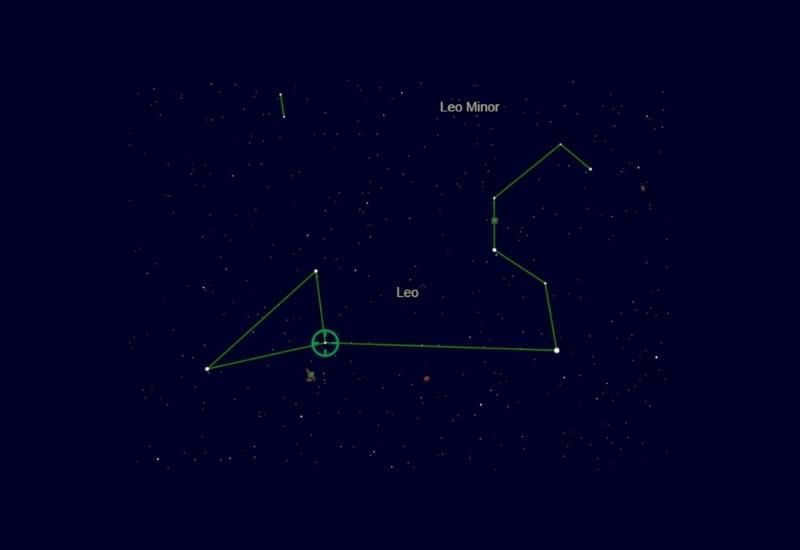
The Constellation Leo’s Asterisms
Locating the renowned Sickle asterism is a breeze due to the distinct pattern of the Leo constellation.
The peculiar pattern consists of the following celestial bodies:

- α Regulus;
- γ Algieba;
- Al Jabah;
- Epsilon of Leo;
- Rasalas;
- Aldhafera.
The asterism known as Veronica’s Hair is easily recognizable in the night sky and has a distinctive shape reminiscent of a question mark. Observers can also spot a unique cluster in the area known as the tail of Leo. This cluster was referred to as a tassel in ancient times and has since been incorporated into the constellations.
The Leo constellation is renowned for its collection of celestial objects that are situated at significant distances from Earth. Astronomers have particularly observed numerous galaxies, including those of the elliptical type. Recent breakthroughs in this challenging field of study have enabled scientists to identify the Leo ring, an unexplored region resembling a dense cloud filled with common universal gases such as hydrogen and helium.
Located between Denebola and Regulus, there are several prominent celestial objects, namely M66 (also known as the Leo Triplet) and M96 (known as Leo I). These objects themselves consist of other galaxies. The Leo Triplet is home to the Messier galaxies NGC 3628, M65, and M66. In the Lion I group, clusters of Messier stars such as 96 and 105 can be observed.
These celestial objects are situated at immense distances from Earth, ranging from 31 to 35 million light-years away. Additionally, the lenticular galaxy NGC 3593 is located at a distance of approximately 20.5 million light-years and is sometimes included in the Leo Triplet.
Messier 65 (M65 or NGC 3623)
This spiral galaxy can be found in the eastern part of the Leo constellation and is approximately 35 million sv years away from our solar system. It spans an area of up to 90,000 light-years. With an approximate magnitude of 10.25, it is part of the Leo triplet, which also includes the star clusters M 66 and NGC 3628. Spotting this galaxy with small binoculars along the Denebola band to Regulus is not a challenging task. It appears as a bright oval-shaped spot. When observing this group of stars through a telescope, it is easy to distinguish the nucleus and the illuminated disk.
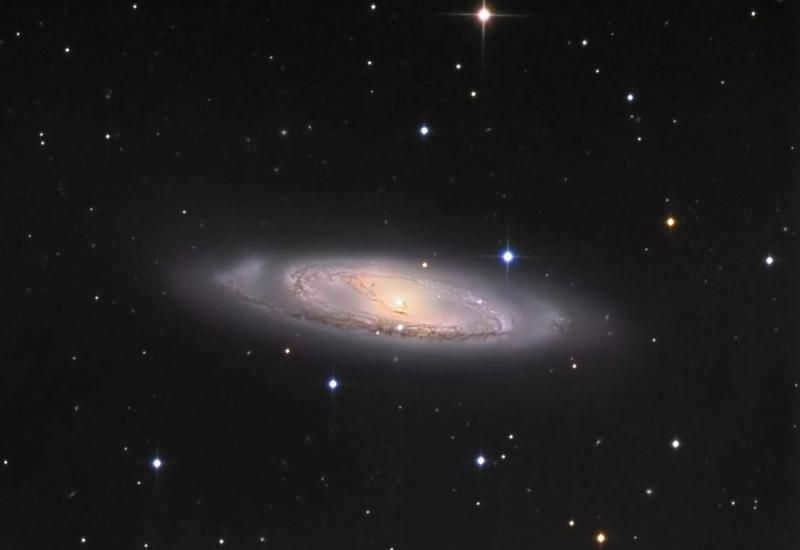
Spiral galaxy Messier 66 (M66 or NGC 3627)
Situated in the Leo constellation, this galaxy is located around 36 million light-years away from Earth. It is one of the most prominent regions within the Leo triplet. French astronomer Pierre Mechene discovered it in 1780. The star cluster spans an impressive area of 95,000 light-years. Contemporary researchers have proposed the existence of four supernovae in the galaxy, namely SN 1973R, SN 1989B, SN 1997bs, and SN 2009hd. Additionally, several enigmatic cosmic objects emitting powerful X-rays have been detected, including one situated in the star cluster’s core.

Galaxy NGC 3628
The appearance of this spiral galaxy is similar to that of the Milky Way and it is located near M65 and M66. In the world of astronomers, it is often referred to as the Hamburger. When viewed from the side, a dark area can be clearly observed, stretching from one edge to the other. NGC 3628 is also a part of the Leo Triplet and is the least bright of the three. It spans an area of 100 thousand light years and is situated 35 light years away from the solar system. The most recent study of this galaxy has revealed the presence of a massive black hole in its central region.
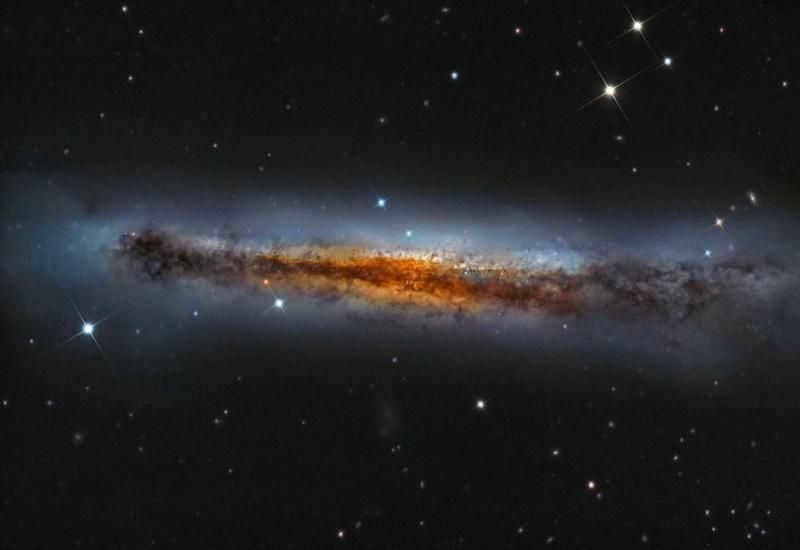
“Perspective” galaxy NGC 2903
William Herschel discovered NGC 2903 in 1784. Based on observations, this star cluster is slightly smaller than the Milky Way and is located 8.9 parsecs away from our solar system. Notably, NGC 2903 has a high rate of new star formation in its central region. This hypothesis is supported by photographs taken by the Hubble telescope, which show young star clusters surrounded by ionized hydrogen clouds. The galaxy is also believed to have a powerful X-ray source of radiation.

Leo Constellation: Ancient Mythology
The mythology surrounding the Leo constellation traces back to the heroic tales of Hercules. According to ancient legends, Hercules, the son of Zeus and Alcmene, bravely defeated the Nemean Lion, using his incredible strength to strangle the mighty beast. In recognition of this extraordinary feat, the lion was immortalized as a constellation by Zeus himself.
In the aftermath of Hercules’ victory, the city of Nemea celebrated with grand games and a period of peace was declared. As a tribute to his son, the god of thunder transformed the lion into a constellation, forever visible in the night sky, ensuring that future generations would never forget the remarkable deeds of Heracles.
Conclusion
The view of the Leo constellation is easily accessible in Russia, making it a popular choice for stargazers. The optimal time to observe this constellation is during the months of February and March.
Each constellation is named after its distinct shape in the night sky, and the Leo constellation closely resembles the silhouette of a cat. Here, you can discover everything you need to know about the constellation of the lion, including its defining features, the stars it comprises, its rich mythology, and much more.

- 1 What is the Leo star constellation?
- 1.1 Where can the constellation Leo be found?
- 1.2 What are the characteristics of the Leo constellation?
- 2.1 Regulus or Regulus.
- 2.2 Denebola
- 2.3 Algieba
- 2.4 Zosma or Dur
- 2.5 Chort or Theta Leonis
- 2.6 Aldaphera
- 2.7 Other stars in the Leo constellation
- 3.1 The Nemean Lion
What is the Leo constellation?
The Leo constellation, also known as the lion constellation, is one of the thirteen constellations of the zodiac that the Sun passes through every year, typically between August and September. It is not as bright as some other constellations due to its proximity to Cancer and Virgo.
Within the Leo constellation, there are several notable stars, including Alpha Leo, which is located at the heart of the lion, and Beta Leo, which represents the lion’s tail. These stars emit a strong brightness, adding to the majestic appearance of this cosmic animal.
In the month of February, the Leo constellation can be easily observed at night without the need for special equipment.
Finding the position of the constellation
To locate the Leo constellation, all you need to do is wait for the arrival of spring. As the weather becomes more pleasant and the visibility improves in the northern hemisphere, around nine o’clock in the evening is the perfect time to observe Leo in the starry sky.
A helpful reference point for locating Leo is to first find the Big Dipper and its seven stars. This constellation resembles a large spoon. Pay close attention until you spot the markers that form the end of the handle, as they will guide you towards Leo, which lies between Cancer the Crab and Virgo the Virgin.
It’s quite simple to identify as its stars shine so brightly that it’s impossible not to notice. Towards the lower part of this cluster of stars, you’ll notice the lion’s tail taking the form of a triangle.
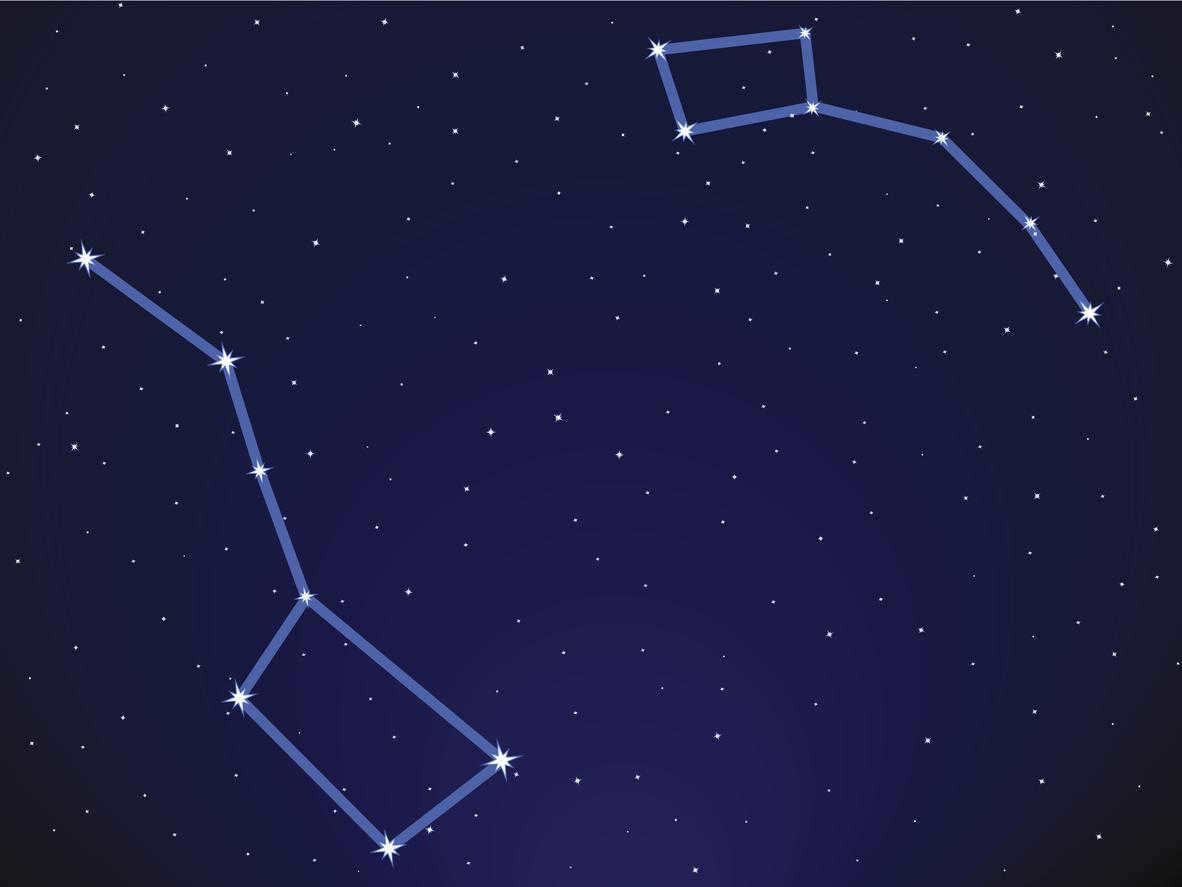
Characteristics of the Leo Constellation
Understanding the true significance of the Leo constellation requires knowledge of its unique characteristics.
- Leo is the fifth constellation in the zodiac group of twelve constellations.
- Leo is one of the oldest constellations and was named in Ptolemy’s Almagest.
- Meteor showers occur in the Leo constellation, with three possible occurrences.
- The Leo constellation contains thousands of galaxies, each with intense brightness and distances between them reaching up to 30 million light years.
- The constellation is traversed by the Star King during the months of August and September.
- It can be found positioned between the constellations of Cancer to the west and Virgo to the east.
- There is a guiding star to the north and the stars Hydra and Crater to the south.
- The constellation’s shape closely resembles the silhouette of a lion, with its mane and head forming a distinctive question mark.
The Leo constellation and its stellar bodies
While the Leo constellation is composed of a significant cluster of stars, some of them are renowned for their size and luminosity. The following stars are particularly noteworthy:
Regulus or Regulus
This star in Leo, also known as Alpha Leo, stands out as the brightest star in the constellation and ranks among the top 20 most luminous stars visible from Earth at night.
The celestial entity Regulus is easily observable throughout much of the year, with the exception of the period when it is in close proximity to the Sun, which occurs between July and August.
As you may be aware, this assemblage of stars can be readily located in the night sky due to the distinctive shape they form, resembling a sickle, with Regulus situated at the enchanting tip of this agricultural implement.
Interestingly, the constellation Leo and particularly Regulus have made appearances in science fiction films like Star Trek, Harry Potter, Babylon, and others.
Denebola
This star is also known as Beta Leo and is the second brightest star in the Leo constellation. It has a size twice that of the Sun and is located over 30 light years away from Earth.
Its name is derived from Arabic and translates to lion’s tail. The physical characteristics of Denebola:
- It is a white star.
- Its temperature exceeds 8000 °K.
- Its luminosity is about ten times greater than that of the Sun.
- It is also larger than the Sun, almost double its size.
- Its lifespan is less than 350 million years.
The Algieba
Comprising a binary system, The Algieba is easily visible during the spring season. It is also known as Gamma Leonis and is located approximately 120 light-years away from Earth.
Consisting of the following stars:
- The primary star, named Gamma Leonis A, is a yellow star with golden hues and is twenty times larger than the Sun.
- Supporting this binary system is Gamma Leonis B, which has a vibrant yellow color and is smaller in size compared to its stellar companion.
To locate this celestial body in the sky, one must ensure that the night sky is clear. The first step is to identify the constellation Leo, which is the mother constellation in this case. At sunset, it can be observed towards the western part of the sky.
As you may be aware, the Leo constellation creates the well-known shape of the Sickle. Algiba, located in the third position of the Sickle, shines quite brightly. To fully appreciate its magnificence, an affordable telescope can be utilized.
Undoubtedly, searching for Algiba in the sky should be included on your list of activities for this upcoming spring season. Ensure that you have your star chart and all necessary equipment prepared in order to capture the allure of these captivating stars to the fullest extent.

Zosma or Dur
This star resides in the Leo constellation, and while it may not shine as brightly as Regulus or Denebola, it still boasts a considerable brightness and ranks among the top 100 brightest stars in the sky.
Its name originates from Arabic, meaning “Lion’s back,” and it is sometimes referred to as Delta Leonis. Here are some key characteristics:
- It is classified as a white star.
- The temperature of Zosma exceeds 7000 degrees Kelvin.
- Its luminosity is more than 20 times that of the sun.
- Zosma has the ability to rotate on its axis at a speed of 200 kilometers per second.
- There are no cosmic dust clouds surrounding Zosma.
- Zosma is estimated to be over 500 million years old.
- Located 60 light years away from the solar system.
Chort or Theta Leonis
Also known as Certan, it is the sixth brightest star in the Leo constellation. However, in terms of overall galaxy classification, it is surpassed by at least 200 stars with higher brightness.
Within the Cat constellation, it is positioned at the rear. The name Chertan is derived from Arabic and translates to small ribs, referring to Leo’s flanks.
Notable features include:
- It shines as a white star.
- Its distance from Earth exceeds 150 light years.
- The temperature nears 10,000 XNUMX °K.
- Despite its considerable distance from Earth, its light intensity remains significant compared to the Sun.
- The planet rotates once every week and travels at an average velocity of 20 kilometers per second.
- The age of Certan is estimated to be around 400 million years.
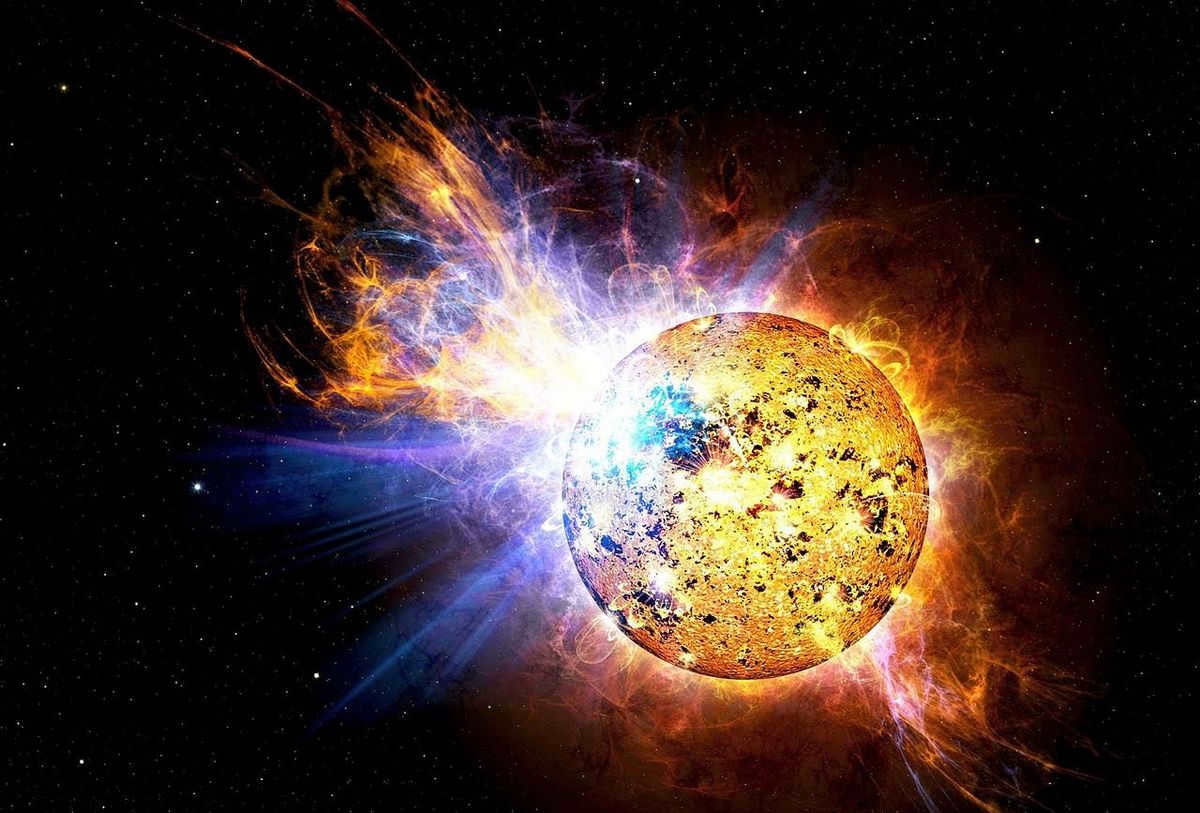
Aldaphera
In line with its fellow stars within the Leo constellation, the moniker of this celestial body is derived from Arabic, signifying twists. This title aptly suits Aldaphera due to its majestic, lion-like mane.
The primary characteristics of this star encompass:
- It falls within the category of yellow-white stars, a rarity in the cosmos.
- Its surface temperature registers at 7000°K.
- Its luminosity surpasses that of the Sun by a staggering 200-fold.
- It completes a full rotation in 6 days, boasting an average speed of 80 kilometers per second.
Other stars in the Leo constellation
- Ras Elased is located in the fifth quadrant of the Leo constellation. It is a giant yellow star with a temperature of over 5000°K and is situated 250 light years away from our solar system. It is also known for having one of the longest rotation periods, lasting more than 6 months.
- This Leonis is a white supergiant and is considered the eighth most luminous star in the Leo constellation. Among the many stars, Eta Leonis is one of the most distant from our solar system, with a distance of over 2000 light years.
- Iota Leonis is a binary star system consisting of a yellow giant and a yellow dwarf. It is located 80 light years away from our solar system. The temperature of Iota Leonis exceeds 6000°K and the age of the star is estimated to be around 1300 billion years.
- Kappa Leonis is classified as an orange giant star with a temperature ranging around 4000 °K. Its light intensity is approximately 100 times greater than that of the Sun, and it takes over a year for it to complete one rotation. The estimated age of Kappa Leonis is about 1.2 billion years.
- Alterf is part of the Leo constellation and is also an orange giant star. It emits a significant amount of infrared radiation and has a temperature exceeding 3500 °K. It is located approximately 300 light years away from our solar system. Similarly to Kappa Leonis, it also takes a year to complete a full rotation on its axis.
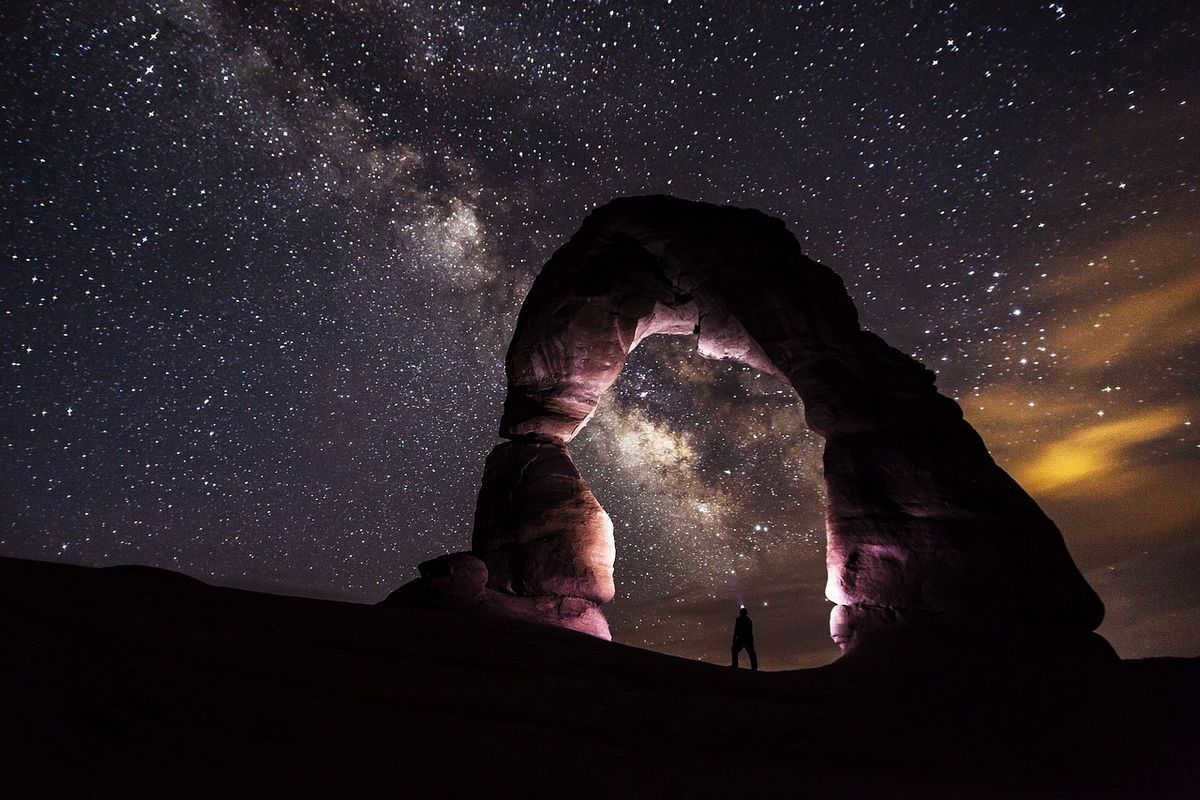
Mythology behind Leo constellation
The tale of the constellation of the ruler of the celestial kingdom revolves around the Nemean lion and Hercules. While he may no longer hold the title of king of the jungle here on Earth, he proudly proclaims himself as the king of the night sky in the galaxy.
The history of this constellation is intertwined with the ceremonial tribute that Zeus, the father of Heracles, wished to bestow upon him after his triumph over the Nemean Lion. The tribute involved placing him in the heavens so that the bravery of his son would be forever remembered.
The Nemean Lion
This creature inspired fear in all who encountered it, leaving a trail of terror in its wake. And its fearsome reputation was well-deserved, as it was the offspring of the god Typhoon, the creator of powerful hurricane winds.
Challengers from all corners attempted to defeat the Nemean Lion, but none succeeded. This is why it became the central focus of the twelve labors assigned to the mighty Hercules.
According to legend, Hera, the wife of Zeus, was angered by his affair with a mortal woman, which resulted in the birth of Heracles. This ongoing conflict brought constant suffering to Hercules, leading him to unleash his fury on Hera, her children, and even some of his own relatives who happened to be present.
However, his sibling managed to locate him and convinced him to seek wise advice from the Delphic oracle. The oracle instructed him to undertake twelve tasks that would help him ease his troubles and guilt.
Embrace the challenge
Without hesitation, young Heracles embraced the challenge, eager to make amends for his transgressions as quickly as possible. The initial task involved putting an end to the relentless pursuit of the Nemean lion, a formidable adversary with an impressive history of triumphs.
To effectively accomplish this task, Heracles devised a brilliant plan to block one of the cave’s entrances where the lion resided. This forced the creature to exit through a vulnerable door, allowing Hercules to seize it by the neck and suffocate it.
After the animal’s life came to an end, he made preparations to remove its skin, and in order to accomplish this challenging task, he heeded the guidance of the goddess Athena. The animal’s skin was utilized to create a suit of armor, complete with a protector featuring the likeness of the Lion’s head.
In this manner, he proceeded to complete the remaining 11 tasks, thereby alleviating himself of the remorse and guilt brought on by his transgression. As a result of his bravery, Zeus bestowed upon him a reward by transforming him into the constellation of Leo, where he would reside in the heavens.
Leo: Symbolism in Astrology
Leo, the fifth constellation in the zodiac, is traversed by the Sun between July and August. In the zodiac chart, however, Leo is classified from August 18 to September 22. Among astrology experts, Leo is considered to have the most significant influence in the entire zodiac.
The colors associated with Leo are yellow, gold, red, and orange. Gemstones and precious metals that align well with Leo include amber, diamond, ruby, and gold. Leo is categorized as a fire sign in the zodiac. Some key traits that shape the personality of those born under this sign include pride, creativity, vanity, fame, greatness, intelligence, and strength.
The Leo sign clashes with Aries and Sagittarius, who are also fiery. Among the air signs, it only harmonizes with Aquarius, individuals with the Leo sign often have conflicts with those who have a Taurus Moon and Scorpio.
Lions maintain excellent relationships with representatives of the Libra and Gemini signs. Those born under the Leo sign act among their peers just as Leo behaves in its natural state, always striving to dominate those around them. The Leo constellation continues to generate new information today, fueling the curiosity of astronomy and astrology enthusiasts and inspiring them to delve deeper into their studies.
If by any chance you happen to have the chance to be in the presence of a telescope and it happens to be a night in the springtime, don’t hesitate to shift your focus towards the celestial sphere and attempt to locate this awe-inspiring and splendid arrangement of stars. You will soon discover that an enchanting revelation awaits you.

The information provided in this article adheres to our editorial guidelines. If you notice any mistakes, please click here to report them.
To learn all about the Leo constellation, visit the full article here.
Leo is a constellation that can be found in the northern sky and covers a vast area. It belongs to the zodiacal group of constellations.
Depicted as an animal in pictures, the Leo constellation is often associated with the Nemean lion. It was first documented by Ptolemy in the second century.
Within the Leo constellation, you can find two bright stars called Regulus and Denebola. The closest star to us is Wolf 259. Additionally, there are several galaxies within this constellation, including M65, M66, M95, M96, M105, and NGC 3628.
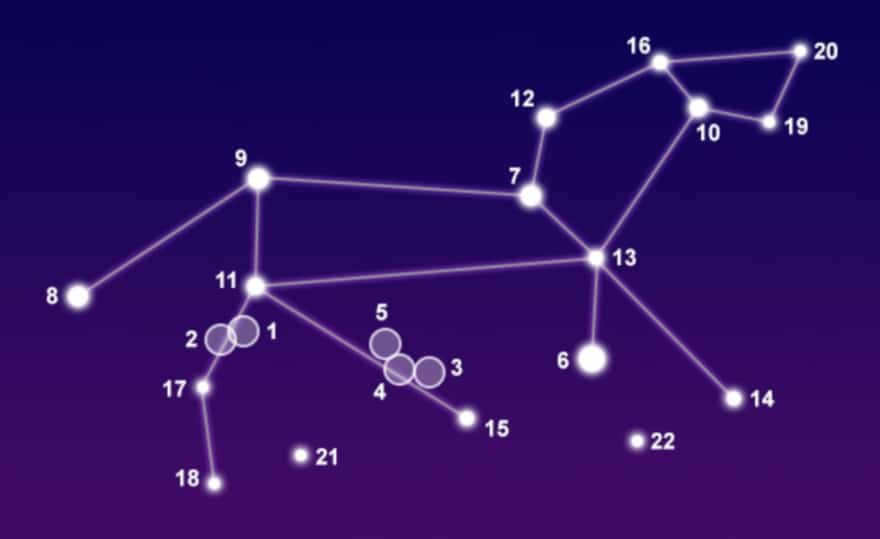
Interesting Facts, Location, and Map
Spanning across an impressive 947 square degrees, Leo is a zodiacal constellation that ranks as the 12th largest in terms of size. It occupies the second quadrant of the northern hemisphere (NQ2) and can be observed at latitudes ranging from +90° to -65°. Leo is bordered by the constellations Cancer, Veronica’s Hair, the Cup, the Lesser Lion, the Sextant, Virgo, the Lynx, and the Big Dipper.
Leo is home to 5 Messier objects, including Messier 65 (M65, NGC 3623), Messier 66 (M66, NGC 3627), Messier 95 (M95, NGC 3351), Messier 96 (M96, NGC 3368), and Messier 105 (M105, NGC 3379). Additionally, it hosts 11 stars that have planets in orbit.
The brightest star in Leo is Regulus, boasting an apparent magnitude that can reach as high as 1.35. This constellation is also associated with two meteor streams. The Leonids meteor shower peaks on November 17-18 and is particularly radiant near the star Algieba. On the other hand, the January Leonids are a smaller stream that reaches its peak on January 1-7.
Leo is a member of the cluster of celestial patterns known as zodiacal constellations, which consists of 12 signs including Aries, Taurus, Gemini, Cancer, Virgo, Libra, Scorpio, Sagittarius, Capricorn, Aquarius, and Pisces. Take a closer look at the star chart to observe the arrangement of stars in the Leo constellation.
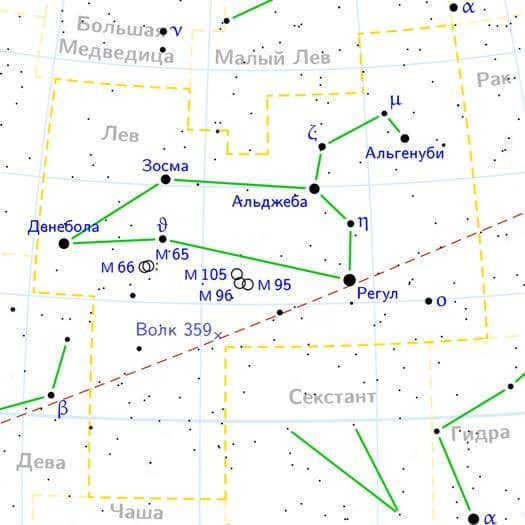
Legend
Leo is considered to be one of the most ancient constellations in the sky. Archaeological evidence suggests that as early as 4000 BC, the people of Mesopotamia had observed a constellation similar to Leo. The Persians referred to it as Shir (Sher), the Babylonians called it UR.GU.LA (“great lion”), the Syrians knew it as Arya, and the Turks named it Artan.
The Babylonians were aware of the star Regulus, which they believed to be “the one at the lion’s breast” or “the star of the king.” This constellation and its brightest star have left their mark on various cultures.
The Greeks associated Leo with the Nemean lion that Hercules had slain. This tale served as one of his legendary feats. Both Eratosthenes and Hyginus wrote that the lion was placed in the sky because it was considered the king of all beasts.
The legendary lion resided in a cavern located in Nemea (southwest of Corinth). It posed a threat to humanity as it would prey on humans. Attempts to slay the lion proved futile, as its hide was impervious to any known weapon. Heracles attempted to use arrows, but they merely rebounded. Eventually, he lured the lion into the cave and strangled it. Utilizing the creature’s claws, he skillfully removed the skin and fashioned it into a protective cloak.
In the night sky, there are six radiant stars arranged in the form of a sickle, symbolizing the lion’s head. The most brilliant of these stars, known as Regulus, represents the lion’s heart. Danebola signifies the tip of the lion’s tail, while Algieba, despite its name translating to “forehead,” actually designates the lion’s neck. Lastly, Zosma denotes the lion’s rump.
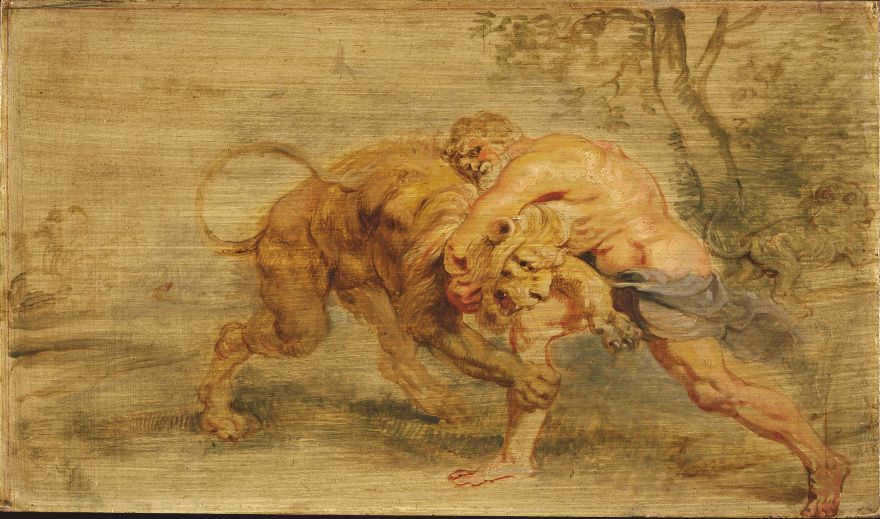
Main celestial bodies
Discover the shining celestial bodies of the astrological constellation Leo with comprehensive descriptions and categorization.
Regulus (Alpha Leo) – Being the first brightest star in the constellation and the 22nd brightest in the entire sky, it possesses an apparent visual magnitude of 1.35. Situated at a distance of 77 light-years, it is a four-star system comprising two pairs of stars.
Regulus A is a binary star system with a spectroscopic double star. It consists of a blue-white star (B7 V) on the main sequence and a companion star that is considered a white dwarf. These stars orbit around a common center of mass every 40 days.
The primary star Regula A is a youthful star, with an approximate age of a few million years and a mass 3.5 times that of our Sun. It rotates at a remarkably high speed (taking approximately 15.9 hours to complete one rotation), which has resulted in its formation into a flattened shape. If it were to spin just 16% faster, the gravitational force would be insufficient to counteract the centrifugal force, leading to its collapse.
Regulus is the nearest bright star to the ecliptic plane, which means that it is frequently obscured by the Moon and occasionally by Mercury and Venus. In the northern hemisphere, it is most visible during the evening in late winter and spring. However, it is not observable on August 22 due to its proximity to the Sun.
The term “Regulus” is derived from Latin and translates to “little king” or “prince”. The Greek equivalent was “Basiliscos”, which shared the same meaning, while the Arabic name “Kalb al-Asad” signifies “heart of the lion”.
Denebola, also known as Beta Leo, is a main-sequence star of spectral type A3 V. It has an apparent visual magnitude of 2.113 and is located at a distance of approximately 35.9 light-years from Earth. Within the constellation Leo, Denebola is the second brightest star and ranks 61st in terms of overall brightness in the night sky. Notably, it can be easily located without the aid of technological instruments.
In terms of physical characteristics, Denebola is 75% more massive than our Sun and has a radius that is 173% larger. Additionally, it shines with a luminosity that is 12 times greater than that of the Sun. Denebola is classified as a variable star of the Delta Shield type, meaning its brightness can fluctuate slightly over a period of several hours. These changes in luminosity amount to a magnitude difference of 0.025, occurring approximately 10 times a day.
With an estimated age of less than 400 million years, Denebola is relatively young. Its rapid rotation speed of 128 km/s has caused it to develop a flattened shape. Moreover, the presence of significant infrared excess suggests the existence of a dust disk in orbit around Denebola.
IC 2391 refers to a cluster of stars that share a common motion but are not bound by gravity. This cluster also includes Alpha Painter, Gomeisa, and other stars in the open cluster IC 2391. The name “Denebola” comes from the Arabic phrase ānabab al-asad, which means “tail of the lion.”
Gamma Lion, also known as Algieba, is a double star consisting of a giant star (K1-IIIbCN0.5) and a companion star (G7IIICN-I). The giant star is 180 times brighter than the Sun, with an apparent visual magnitude of -2.28. The companion star is 50 times more luminous than the Sun, with an apparent magnitude of 3.51, and is 10 times larger in diameter. The two stars have an orbital period of 500 years. In November 2009, astronomers discovered a planet orbiting the giant star.
With a distance of 130 light years and a total apparent visual magnitude of 1.98, Algieba is easily visible even in a small telescope. Under optimal conditions, both the red and greenish components can be observed. The name “Algieba” derives from the Arabic word for “forehead”.
Algieba, together with Zeta Leo and Eta Leo, is sometimes referred to as the Sickle.
Zosma, also known as Delta Lion, is a white main-sequence star (A4 V) with a visual magnitude of 2.56. It is located 58.4 light-years away. In terms of size, it is about 214% of the radius of the Sun and shines approximately 15 times brighter. In around 600 million years, it will evolve into a red giant. The star’s rotation speed is approximately 180 km/s, which results in a flattened shape and a wider equator compared to the poles.
It is possible that it is a member of a moving cluster of stars in the Big Dipper, which are stars that share a common origin and move together in space. The ancient Greek word “Zosma” means “belt” and refers to its location on the thigh of the lion.
Hort, also known as Theta Lion, is a white main-sequence star (A2 V) with a visual magnitude of 3.324, making it visible to the naked eye. It has a mass 2.5 times that of the Sun and is located 165 light years away from us.
Unlike the Sun, Hort is relatively young with an age of 550 million years. It emits a significant amount of infrared radiation, indicating the presence of a dust disk surrounding it. The star rotates at a speed of 23 km/s.
There are several traditional names for Hort, including Hort (derived from the Arabic word for “small rib”), Coxa (Latin for “thigh”), and Certan (derived from the Arabic words for “two small ribs”).
Kappa Lion is a binary star system (K2III) with a visual magnitude of 4.46 and a distance of 210 light-years. Its traditional name, Al-Minlar, translates from Arabic as “the lion’s face”.
The star Lambda in the constellation of Leo is classified as a K5 star, with a visual magnitude of 4.32 and a distance of 336 light-years. Its traditional name, “Alterf”, is derived from the Arabic word aṭ-ṭarf, meaning “species of the lion”.
Omicron Leo is a binary star system located 135 light-years away. It consists of a giant star (F9III) and a main-sequence star (A5mV), with a visual magnitude of 3.53.
This particular star in the constellation of Leo is a white supergiant (A0 Ib) with a visual magnitude of 3.511 and a distance of 2000 light-years. It is approximately 5600 times brighter than the Sun and has an absolute magnitude of -5.60. This star is believed to be part of a binary system.
Zeta Leo is a massive (F0 III) star with a visible magnitude of 3.33 and a distance of 274 light-years. It shines 85 times brighter than our Sun. It is accompanied by the optical companion 35 Leo, which has a visible magnitude of 5.90 and is located 325.9 arc seconds away from the main star. The name Adhafera originates from the Arabic word al-βafīrah, which translates to “curl” or “braid”.
Rasalas (Mu Leo) is a star classified as K3 with a visible magnitude of 4.1 and a distance of 133 light-years. The term “Rasalas” is derived from the Arabic phrase ra’s al-‘asad aš-šamālī, which means “the northern (star) of the lion’s head”.
Epsilon of Leo is a luminous giant (G1 II) with an apparent magnitude of 2.98 (the fifth brightest in the constellation) and a distance of 247 light-years. It is approximately 162 million years old. The name Ras Elased is derived from the Arabic phrase rās al-‘asad al-janūbī, which means “the southern star of the lion’s head”. It is 288 times brighter than the Sun, 4 times more massive, and 21 times larger in radius. Epsilon of Leo is a variable Cepheid star, exhibiting fluctuations in magnitude of 0.3 every few days.
Rho Lion is a binary star system with an apparent magnitude of 3.856 and a distance of 5000 light-years. The B1 spectral classification indicates that the object has evolved into a supergiant. It has a mass 21 times that of the Sun, a radius 37 times larger, and is 295,000 times brighter. It has a velocity of 30 kilometers per second. The primary component is a blue supergiant, accompanied by a companion located at 0.11 angular seconds and having a visual magnitude of 4.8.
Iota the Lion is a double star that can be observed spectroscopically. It belongs to the F3 V spectral class and has a visual magnitude of 4.00. This star is located at a distance of 79 light-years from our planet. Due to the close proximity of the star system, it is quite challenging to observe it even with the help of a telescope.
Sigma Lion, on the other hand, is a blue-white star classified as B9.5Vs. Its apparent magnitude reaches 4.044, and it is situated approximately 210 light-years away.
Wolf 359 stands out as a red dwarf star of the M6.5Ve spectral type. It has an apparent visual magnitude of 13.54 and is located 7.78 light-years away from Earth. Despite its relatively close distance, Wolf 359 can only be detected with a large telescope. This star is considered one of the least numerous and faintest stars ever discovered. It emits only 0.1% of the sun’s energy, and its mass is about 8% of the sun’s mass, while its radius is around 16% of the sun’s radius. Wolf 359 is relatively young, being less than a billion years old.
Gliese 436, the third closest star to the Sun after Alpha Centauri and Bernard’s Star, is frequently referenced in science fiction literature. Fans of Star Trek will recognize it as the site of a major battle where Starfleet ships were destroyed.
Gliese 436 is classified as a red dwarf (M2.5 B) with a visual magnitude of 10.67 and is located 33.1 light-years away. In 2004, the exoplanet Gliese 436b was discovered orbiting this star, followed by the discovery of UCF-1.01 in 2012.
CW Leo, also known as IRC + 10216, is a carbon star surrounded by a thick dust envelope. It is situated at a distance of 390-490 light-years from the Sun and exhibits variations in brightness over a 649-day period. While its nominal luminosity is 11,300 times that of the Sun, it follows a pulsation cycle ranging from 6250 to 15800 solar luminosity, resulting in an apparent visual magnitude that varies from 1.19 to 10.96.
At an advanced stage of development, the star is shedding its outer layer and undergoing a transformation into a white dwarf. The outer shell, estimated to be 69,000 years old, continues to diminish in mass each year. Experts believe that the expanded shell contains a minimum of 1.4 solar masses of expelled material.
Originally discovered in 1969 by American astrophysicist Eric Brecklen.
R Leo is classified as a red giant (M8IIIe) with a visual magnitude ranging from 4.4 to 11.3 and a period of 312 days. It is approximately 320-350 times larger than the radius of the sun. This star is categorized as a Mira variable, which means it is a pulsating variable star in the later stages of its evolution. It has a deep red color and its pulsation periods can span over 100 days. Eventually, R Leo will shed its outer shell to create a planetary nebula and transform into a white dwarf.
It is located at a distance of 370 light-years. When it is at its brightest, it can be seen with the naked eye. However, in other cases, a telescope with a minimum size of 7 centimeters will be required.
Astronomical Objects
Messier 65 (M65, NGC 3623) is an intermediate spiral galaxy with a visual magnitude of 10.25 and a distance of 35 million light-years. It was first observed by Charles Messier in 1780. Together with Messier 66 and NGC 3628, it forms the well-known Leo Triplet. The galaxy contains very little dust and gas and does not have active star formation. The majority of its stars are old.
The distortion of M65’s disk, as well as the presence of areas with star formation, suggests that the galaxy is interacting with another object.
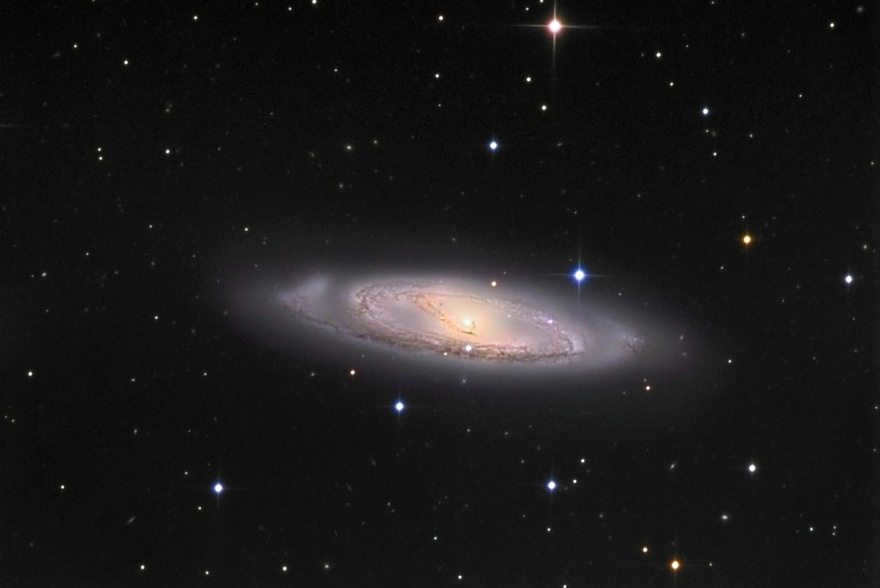
Messier 66 (M66, NGC 3627) was discovered by Charles Messier in 1780 and is classified as an intermediate spiral galaxy. Its visual magnitude is 8.9 and it is located 36 million light-years away. The galaxy spans a distance of 95,000 light-years. Of particular interest are the dusty streaks and bright star clusters within it. Messier 66 is part of the Leo Triplet, a group of three galaxies.
In the past, M66 and NGC 3628 have experienced a collision. This interaction resulted in a highly concentrated central mass in Messier 66, a high ratio of molecular to atomic mass, and the formation of a non-corrotating cluster of HI material originating from the spiral arm.
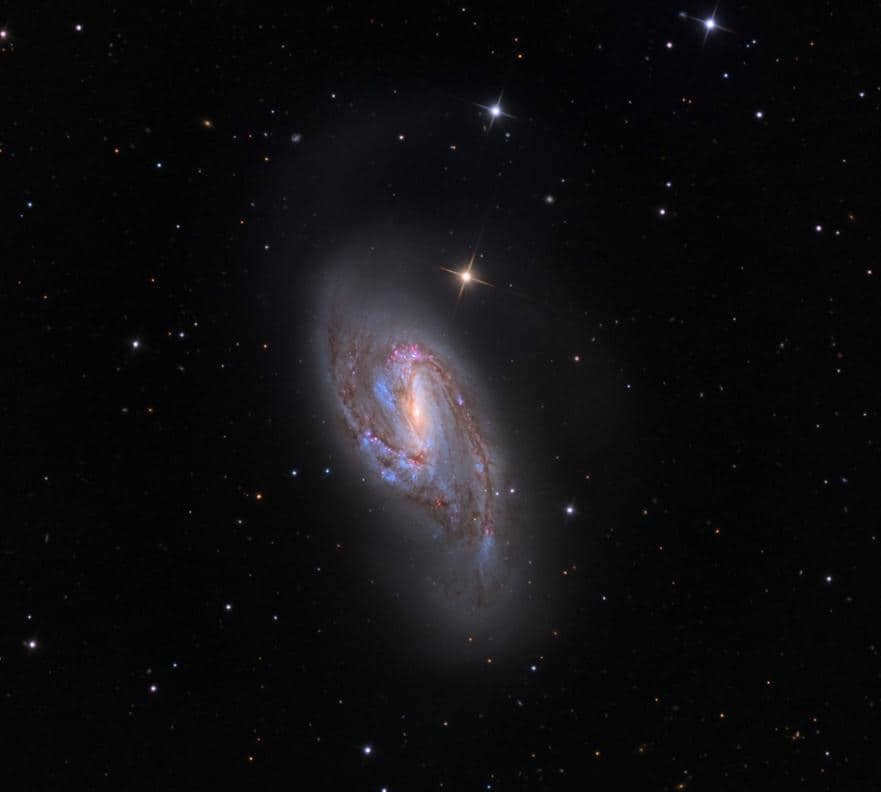

This image showcases M66 (NGC 3627) as observed by the Spitzer telescope’s infrared camera. Scientists believe that the distorted shape is caused by its interactions with M65 and NGC 3628.
Messier 95 (M95, NGC 3351) is a massive spiral galaxy with an apparent magnitude of 11.4 and lies at a distance of 38 million light-years. The nucleus is surrounded by a circular region where stars are actively forming, spanning approximately 2000 light-years in diameter.
M95 is part of the M96 cluster, which also consists of M96, M105, and 9 other galaxies. Astronomer Pierre Mechene discovered the galaxy in 1781, and just 4 days later Charles Messier included it in his catalog. In March 2012, scientists observed a supernova in this region.
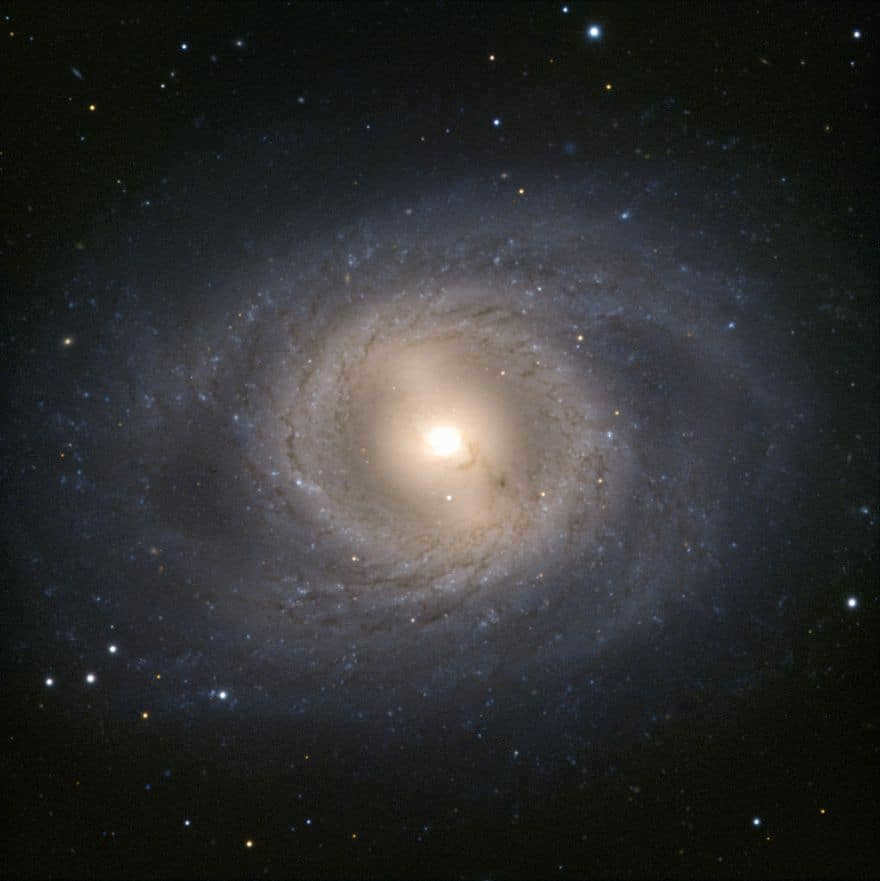

The Galaxy M95 is positioned towards us, providing a spectacular sight of its spiral structure, where the arms create a nearly flawless circular shape. Its appearance bears a resemblance to the majestic mane of a lion. What truly stands out is the shimmering golden core, surrounded by a ring that spans almost 2000 light-years and is actively forming stars.
Pierre Mechene discovered it on March 20, 1781, and a couple of days later it was included in Charles Messier’s catalog. In May 1998, astronomers observed a Type Ia supernova, known as SN 1998bu.
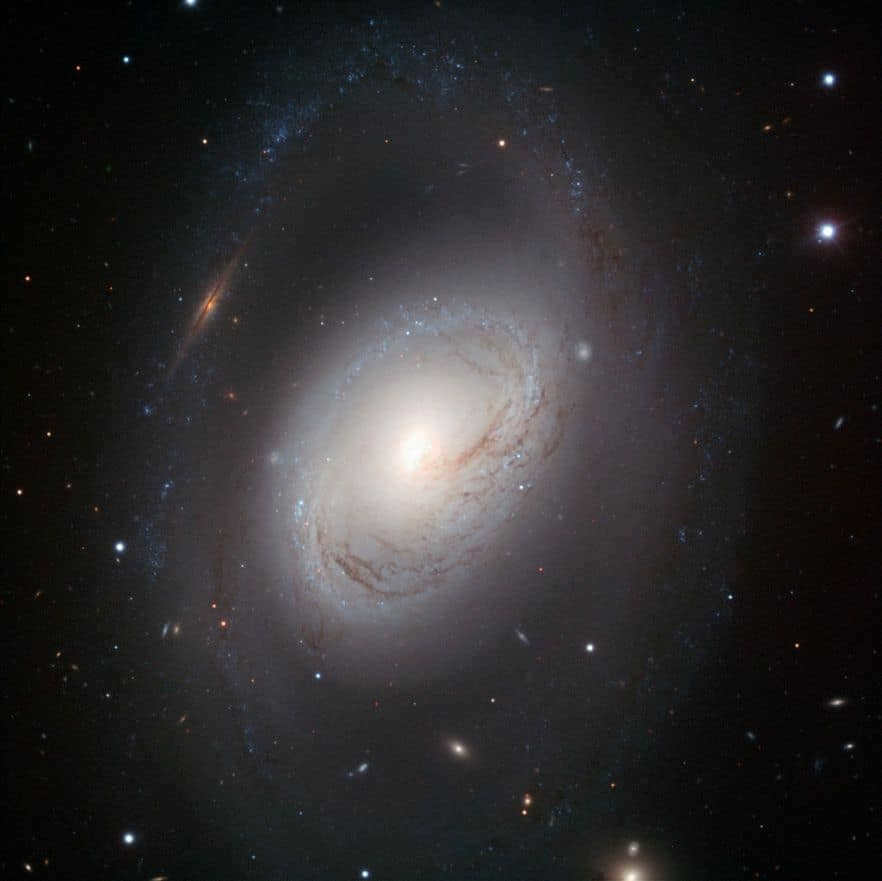

M96 is the biggest galaxy in the M96 group. When its spiral arms are taken into account, it has a diameter of 100,000 light-years, just like the Milky Way. Any minor imperfections can be explained by interactions with other members of the group or past collisions.
Messier 105 (M105, NGC 3379) is an elliptical galaxy with a visual magnitude of 10.2 and a distance of 32 million light-years. It contains a supermassive black hole. Pierre Mechene discovered it in March 1781, a few days after discovering M95 and M96.

NGC 3628 is a spiral galaxy located 35 million light-years away from us. William Herschel discovered this galaxy in 1784. One of the remarkable features of this galaxy is its long tidal tail, which stretches for 300,000 light-years. Additionally, there is a wide band of dust that obscures the outer edge of the spiral arms. NGC 3628 is also known as a member of the Lion Triplet.


NGC 3628 is captivating not only due to its spiral structure, but also because of the presence of a dark band of dust that stretches across the disk’s plane, which has been slightly distorted as a result of its interaction with neighboring galaxies. This unique X-shape is formed by young stars, gas, and dust, all of which contribute to the formation of the galactic bulge. In 1966, this galaxy was designated as a member of the Atlas of Special Galaxies under the name Arp 317, as it did not fit within Hubble’s standard classification system.
The Lion’s Ring is a massive ancient collection of hydrogen and helium gas that encircles two galaxies. It was first observed by radio astronomers back in 1983.
NGC 3607 is a spiral galaxy with a visual magnitude of 10.8. It belongs to the NGC 3607 group of galaxies.
NGC 3593 is a spiral galaxy with a visible magnitude of 12.6.
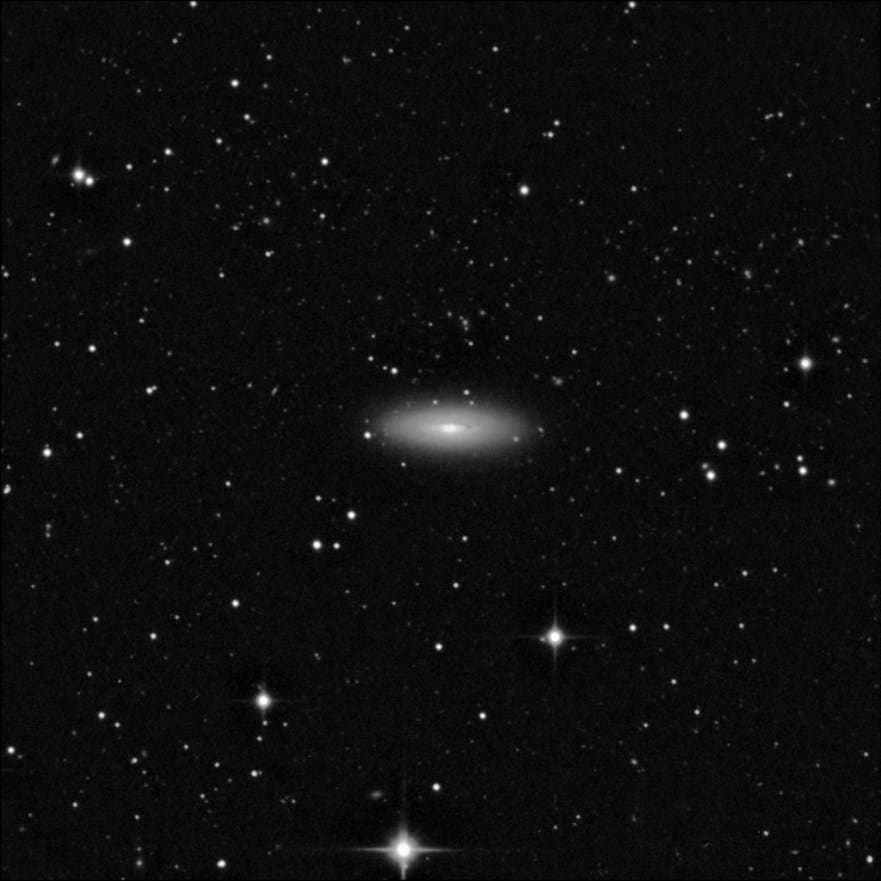
NGC 3384 is a galaxy in the shape of an ellipse that is located 35.1 million light-years away from Earth. It was first observed by William Herschel in the year 1784. The central region of the galaxy primarily consists of very old stars. More than 80% of these stars are of the second generation and have an age of over one billion years. NGC 3384 is part of the M96 group of galaxies.
NGC 3842 is another example of an elliptical galaxy. It is known for hosting one of the largest black holes ever discovered, which has a mass equivalent to 9.7 billion times that of our Sun. The galaxy has an apparent magnitude of 12.8 and is located approximately 331 million light-years away from us.
NGC 3596, on the other hand, is classified as an intermediate spiral galaxy and has a visual magnitude of 12.0. It was also first observed by William Herschel in 1784. If you want to locate this galaxy, you should look for it near the bright star known as Theta Leo.
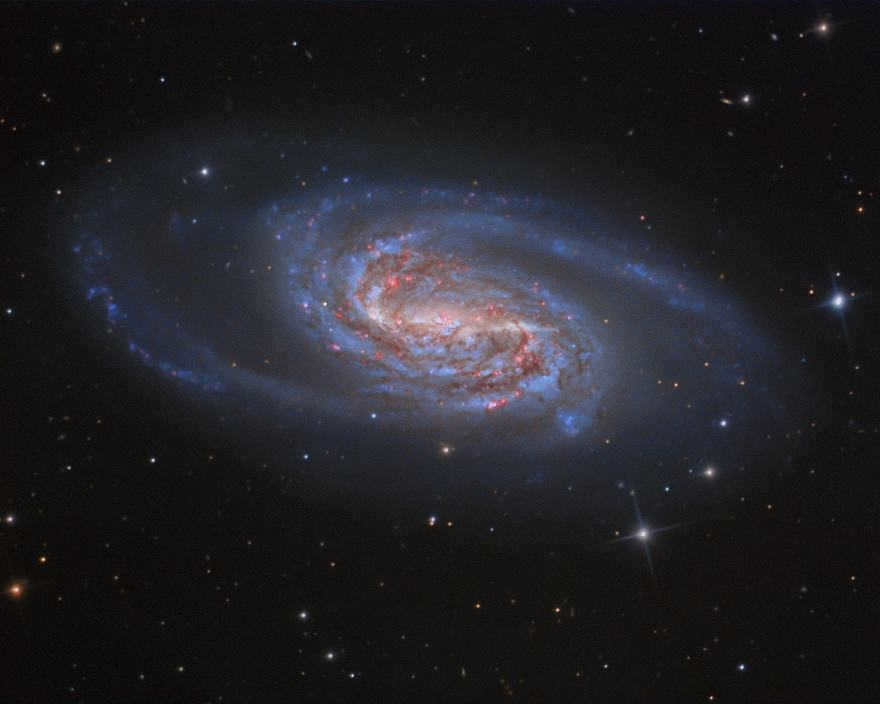
NGC 3626 is a spiral galaxy with a medium-density and a visual magnitude ranging from 10.6 to 10.9. Situated approximately 70 million light-years away, it is positioned near Delta Lion (Zosma). NGC 3626 is a part of the NGC 3607 group.
Discovered on April 5, 1864 by German astronomer Albert Mart, NGC 3357 is an elliptical galaxy.
If you want to explore the zodiacal constellation Leo more extensively, you can utilize not only our photographs but also 3D models and an online telescope. For those who prefer independent exploration, a starry sky map will suffice.

Without a doubt, Leo stands out as the most stunning constellation among all zodiacal constellations. It holds the twelfth spot on the list of the largest celestial objects. It has been determined that the total area covered by Leo is approximately 947 square degrees.
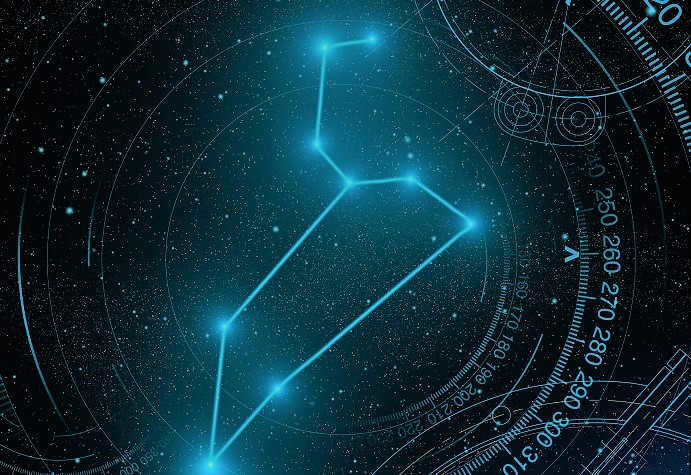
What is the location of the Lion constellation?
The majestic ruler of the animal kingdom can be found in the Northern Hemisphere. More specifically, it resides between the constellations of Virgo and Cancer.
Being a part of the zodiacal circle, Leo is positioned along the ecliptic. In simpler terms, it lies on the Sun’s celestial path throughout the year, which can be observed by us from Earth.
Furthermore, the sky surrounding the Leo constellation is adorned with various prominent neighbors such as the Lesser Leo, the Big Dipper, Virgo, Cancer, Hydra, Lynx, Sextant, Veronica’s Hair, Bowl, and Lynx.
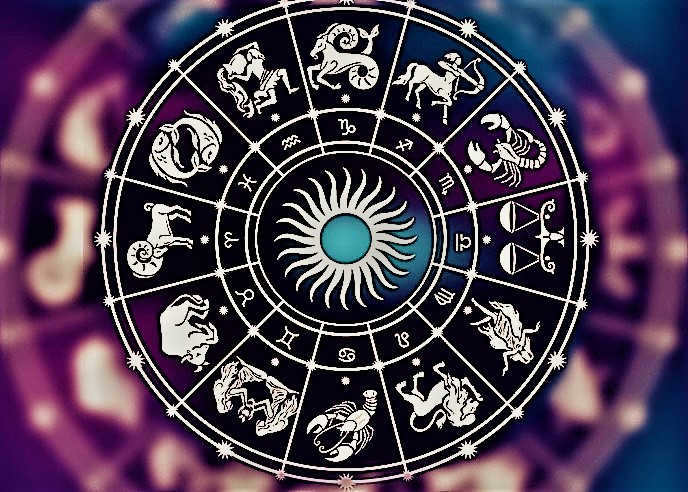
Leo constellation stars
In reality, the Leo constellation contains numerous fascinating celestial bodies. Regrettably, the majority of them are only visible through a telescope equipped with a sufficiently large main mirror.
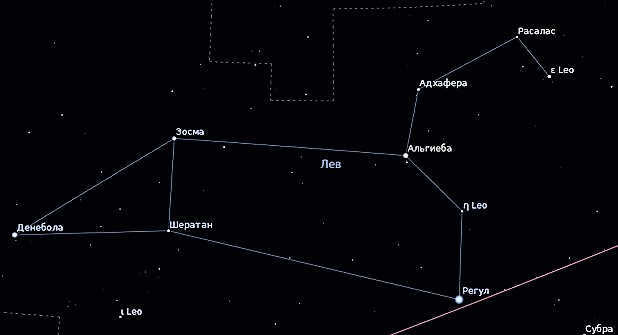
Denebola-Beta is the second brightest celestial object in Leo.
Algieba-Gamma is a binary system consisting of a giant star and its companion.
Zosma–Delta is characterized by a white-colored luminary and belongs to the main sequence.
HortTheta is similar to Delta.
Kappa is a dual system. Interestingly, it is pronounced as “muzzle” in Arabic.
Lambda is a K5-class lion. In Arabic, it means “the appearance of a lion.”
Omicron is a binary system with a giant star and a main-sequence star.
This particular star is a supergiant with a distinct white color.
Rasalas – Mu is a member of the K3 class of stars. Furthermore, it is located to the north of the head.
Epsilon is a brilliant giant that can be found to the south of the head.
Rho is a binary star system, while Iota is a spectroscopic pair system.
Sigma is characterized by its blue-white luminosity.
Wolf 259 is a red dwarf, and it is the closest star to Earth in this region.
Also included in this group of stars are Gliese 436, CW, and R.
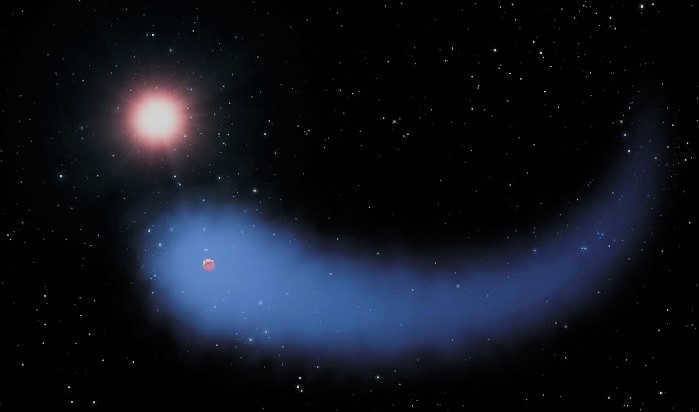
We are all trapped in the quagmire, but some of us are looking up at the stars
Oscar Wilde
Other heavenly bodies
The constellation contains several spiral galaxies, namely M 65, M 66, M 95, M 96, NGC 3628, NGC 3596, NGC 2903, NGC 3626, NGC 3607, and NGC 3593.
In addition, Leo is home to a number of elliptical galaxies such as M 105, NGC 3384, NGC 3842, NGC 3357.
Interestingly, scientists have recently made a discovery known as the Lion’s Ring. It happens to be a massive cloud made up of helium and hydrogen.
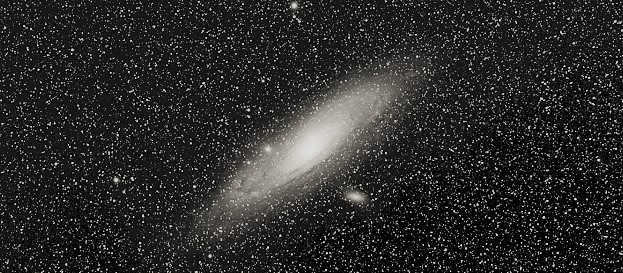
Constellations
In ancient times, the star cluster in the tail region was known as the Tassel. However, it was later recognized as a constellation and given the name Veronica’s Hair.
Furthermore, among the six main stars of Leo, there is a well-known constellation known as the Sickle. Its shape is often likened to an inverted question mark.
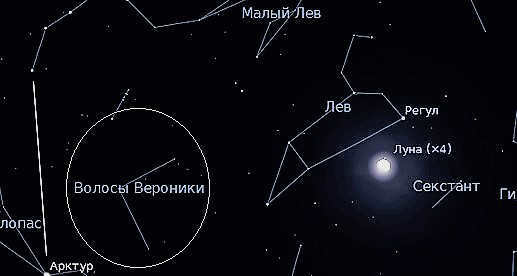

Mythology
There are numerous tales regarding the origin of the Leo constellation.
One such legend is from ancient Greek mythology and revolves around the Lion of Nemea. According to the myth, Heracles successfully defeated the formidable beast and offered it as a sacrifice to Zeus. This was in fact one of the earliest known deeds of Hercules. In recognition of his son’s victory, Zeus transformed the creature into a constellation, ensuring that the triumph would be forever remembered by mankind.
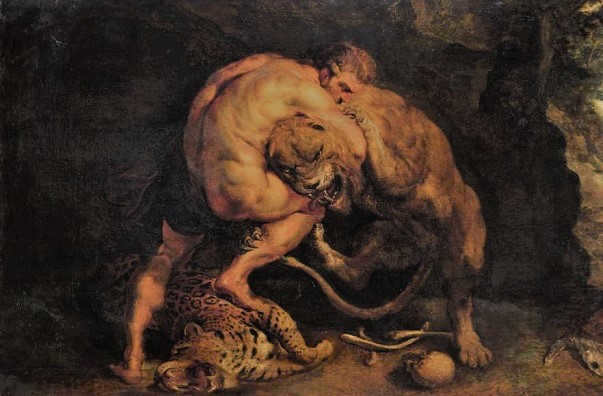
Furthermore, ancient civilizations often linked celestial bodies with seasonal occurrences. Consequently, the Egyptians designated the stars of the Lion constellation based on the time when they radiated brightly in the heavens. This was during the peak of intense heat, when the desert transformed into the domain of the mighty king of beasts.
Moreover, there is a connection to the tale of the genesis of the principal star – Regulus. As commonly known, its name signifies the Lion’s heart.





